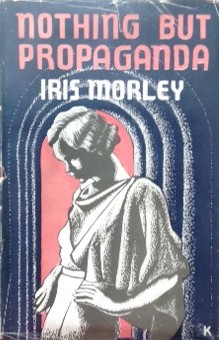Inspiring Older Readers
 posted on 05 Sep 2017
posted on 05 Sep 2017
Nothing But Propaganda by Iris Morley
Iris Morley (1910 – 1953) is now a largely forgotten novelist who published primarily during the years of the Second World War and in the immediate aftermath. Born into an upper-middle class military family, Morley had aspirations to act on the stage but soon abandoned that in favour of novel writing. While living in the USA she married rather hastily and divorced quickly, moving instead into a relationship and eventual marriage with another novelist who also achieved some minor renown, Alaric Jacob.
Morley’s writing at this point was focussed on light historical romance and her first book – The Proud Paladin - was published in New York in 1936. The couple returned to England where Morley published a trilogy of historical novels with James Scott, the Duke of Monmouth and William III as central characters.
However, in 1944 Jacob and Morley went to the Soviet Union in order to complete Jacob’s work on Soviet Ballet and the experience seems to have had a telling impact on Morley’s outlook and ideology. Returning home she became a journalist with The Observer and The Yorkshire Post but, perhaps more significantly, she became, along with Jacob, an active member of Communist Party.
It’s hard to find very much about which issues Morley and Jacob got involved in or the level of their influence but it was sufficient for them to be included on George Orwell's now infamous death-bed list of people he considered unsuitable to be authors for the Government’s Information Research Department. Partly as a result of this both found work increasingly hard to come by even though the couple had separated by the early 1950s. Morley died in 1953 but I can’t find a record of what brought about her premature death.
Nothing But Propaganda, published in 1946, sees Morley moving away from historical romance to something much more political and in the social realist tradition. It is, I suspect, largely autobiographical and features a central character, Catherine, who comes from a middle class military background, lives briefly in the USA, marries unwisely, divorces and remarries a Communist journalist of The Globe newspaper, Nick Rainsborough. Nick, described as a ‘Red’ and who has been in Spain during the Civil War sweeps Catherine off her feet and together they return to England. Immediately however Nick has to go off to be a correspondent in Moscow leaving Catherine to fend for herself and what follows is a story of ideological and intellectual contradictions and compromise. Central to the story is the contrast between Catherine’s politically committed world view and the romantic, other-worldliness of her sister Felicitas (Fel). In the end both sisters have to work out their own solutions to their individual dilemmas – for Felicitas there is the shock, emotional and financial, of her father’s sudden death when a stray bomb destroys the house and for Catherine there is the turmoil of a love affair with a ‘serious-minded physicist’.
But perhaps, for me at least, the most entertaining aspect of this book is that Catherine earns her living working in a London-based Communist co-operative bookshop – which is in fact where she meets her ‘serious-minded physicist’. Morley describes the bookshop in this way:
Situated in Bloomsbury – inevitably Bloomsbury – the bookshop had been born during the days of the Popular front movements, and among its 300-odd members contained all shades of Left opinion, from the palest pink Fabians to Reds of the deepest dye. On the Executive Committee…Reds predominated, though not always without internecine struggle.
In the shop itself these ideological struggles play out in a minor drama between employees:
Catherine often reflected that an idealist would be disillusioned by these quarrels and combats, which raged as fiercely among the comrades as in the ordinary commercial world. Yet they were conflicts with a difference….In fighting Pringle, Augusta was not simply reacting to a personal slight, she was also insisting on the practice of democracy as well as the theory.
Morley’s description of the dynamics of the co-operative bookshop surpass any of the other relationships she paints in the book. Although the book shop is fictional and set in Bloomsbury, the dates involved make it more than possible that this is a portrait influenced by, if not based on, the famous radical bookshop Housman’s which is located just down the road in Kings Cross.
In truth the central storylines of Catherine and Felicitas are not in themselves terribly interesting or, to my mind, well written – in fact the book can be pretty dull in places. But it comes to life in the bookshop and that alone, for someone with my bookish obsessions, makes it worth the effort.
Terry Potter
September 2017